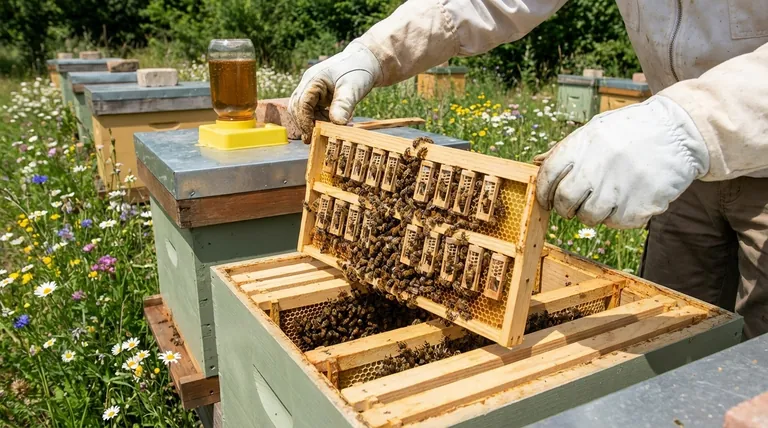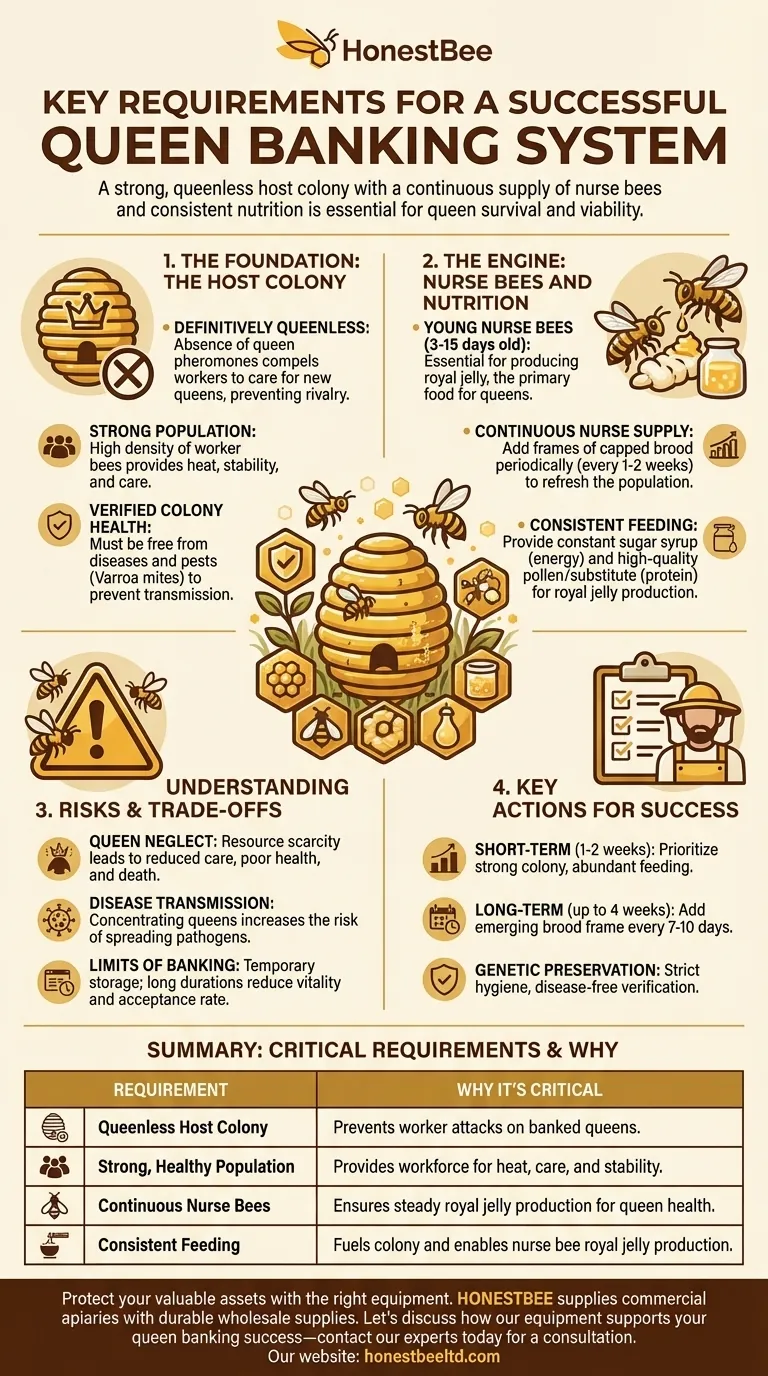To create a successful queen banking system, you must establish a strong, healthy, and queenless host colony that is populated with a continuous supply of young nurse bees. This colony must also be consistently well-fed with both carbohydrate and protein sources to ensure the banked queens receive the care required for their survival and future viability.
The core principle is not to simply store queens, but to create a dynamic, resource-rich environment that mimics the ideal conditions of a hive actively supporting its own royalty. A failure to manage the host colony's population and nutrition is a failure of the bank itself.

The Foundation: The Host Colony
The colony that houses your banked queens is the single most important factor in the system's success. It must be prepared and managed with specific biological triggers in mind.
Why "Queenless" is Non-Negotiable
A honey bee colony is governed by pheromones, with the queen's scent signaling her presence and suppressing the rearing of new queens. A banking colony must be definitively queenless.
The absence of a reigning queen's pheromones is what compels the worker bees to accept and care for the new queens introduced in cages. If a resident queen exists, the workers will identify the banked queens as rivals and attempt to destroy them.
The Importance of Population Strength
A successful bank requires a high population density. A strong, populous colony has the workforce needed to generate heat, maintain environmental stability, and, most importantly, provide attendant care to multiple queens.
A weak or dwindling colony will not have the resources to properly feed and tend to the banked queens, leading to neglect and a rapid decline in their health.
Verifying Colony Health
The bank is only as healthy as its host. The chosen colony must be free from diseases and significant pest pressure, particularly Varroa mites.
A stressed or sick colony cannot provide adequate care. Furthermore, a contaminated bank can act as a vector, transmitting pathogens to your valuable queen stock.
The Engine: Nurse Bees and Nutrition
Once the colony structure is correct, success depends on the resources you provide to the bees who perform the actual labor of caring for the queens.
The Critical Role of Young Nurse Bees
Only young worker bees, typically 3 to 15 days old, produce the royal jelly necessary to feed queens. The health and longevity of your banked queens are directly dependent on this crucial substance.
An aging colony population lacks the physiological capacity to provide this essential nourishment, and the bank will quickly fail. Therefore, you must ensure a steady, emerging supply of nurse bees.
How to Ensure a Supply of Young Bees
The most effective way to maintain a young population is to periodically add frames of capped brood from other healthy hives.
As these new bees emerge, they replenish the population of nurse bees, guaranteeing a continuous supply of royal jelly for the queens in the bank. This should be done every one to two weeks, depending on the bank's size and duration.
What "Well-Fed" Truly Means
Being "well-fed" is more than just providing sugar water. Consistent, high-quality nutrition is essential for the production of royal jelly.
This means providing a constant supply of carbohydrates (sugar syrup) for energy and, crucially, protein (pollen or a high-quality pollen substitute). Without adequate protein, nurse bees cannot produce the food your queens need.
Understanding the Trade-offs and Risks
A queen bank is a powerful tool, but it is an artificial system with inherent vulnerabilities that you must manage proactively.
The Risk of Queen Neglect
If the nurse bee population declines or nutritional resources become scarce, the colony's instinct for self-preservation will take over. The workers will begin to neglect the banked queens, resulting in reduced viability, poor acceptance upon introduction, and eventual death.
The Potential for Disease Transmission
Concentrating queens, potentially from different genetic sources, into a single colony creates a risk. If the host colony harbors a latent disease, it can easily spread to all the queens in the bank. Rigorous health screening is essential.
The Limits of Banking Duration
Banking is a temporary holding strategy, not a long-term storage solution. While queens can be banked for several weeks, their vitality and egg-laying performance can decline over time. The longer a queen is banked, the higher the risk of poor acceptance when she is later introduced to a new colony.
Key Actions for a Successful Queen Bank
Your management strategy should align with your specific goals for the queen bank.
- If your primary focus is short-term holding (1-2 weeks): Prioritize selecting an exceptionally strong, queenless colony and provide constant, abundant feeding from day one.
- If your primary focus is longer-term viability (up to 4 weeks): The most critical action is to add a frame of emerging brood every 7-10 days to refresh the nurse bee population.
- If your primary focus is genetic preservation: Implement strict hygiene and health protocols, ensuring both the host colony and the queens being introduced are verified to be disease-free.
By mastering these principles, you transform a simple storage system into a thriving biological nursery that protects your most valuable assets.
Summary Table:
| Key Requirement | Why It's Critical |
|---|---|
| Queenless Host Colony | Prevents worker bees from seeing banked queens as rivals and attacking them. |
| Strong, Healthy Population | Provides the workforce for heat, stability, and attendant care for multiple queens. |
| Continuous Supply of Young Nurse Bees | Ensures a steady production of royal jelly, the essential food for queen health. |
| Consistent Carbohydrate & Protein Feeding | Fuels the colony and enables nurse bees to produce the nutrition queens need to thrive. |
Protect your most valuable assets with the right equipment. A successful queen bank starts with a strong, manageable hive. HONESTBEE supplies commercial apiaries and beekeeping equipment distributors with the durable, wholesale-focused supplies needed to build and maintain thriving operations. Let's discuss how our equipment can support your queen banking success—contact our experts today for a consultation.
Visual Guide

Related Products
- No Grafting Queen Rearing Kit: System for Royal Jelly Production and Queen Rearing
- JZBZ Push-In Queen Cell Cups for Beekeeping
- Brown Nicot Queen Cell Cups for Breeding Queen Bees Beekeeping
- JZBZ Type Wide Base Plastic Queen Cell Cups for Base Mounting and Queen Rearing
- Plastic Chinese Queen Grafting Tool for Bee Queen Rearing
People Also Ask
- What are the developmental periods for different bee castes? Master the 16, 21, and 24-Day Timelines for Hive Success
- How can beekeepers start a honey bee breeding program? Build a Superior, Resilient Apiary
- What should be done once eggs are present in the comb box? A Guide to Maximizing Queen Rearing Success
- What are the stages involved in queen raising? A Guide to Controlled, High-Quality Queen Production
- What is the timeline for queen breeding? A 28-Day Guide from Egg to Laying Queen










